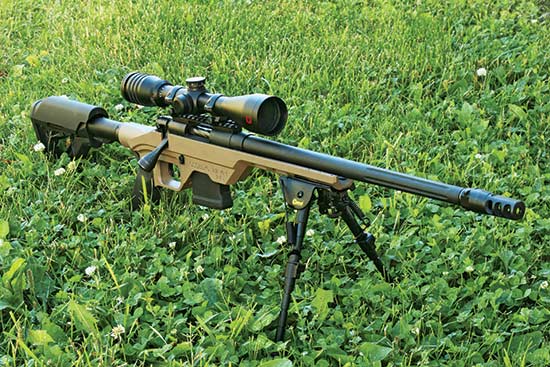The Essential Interface
Rifle Stock Materials Have Come A Long Way

Today, aluminum is becoming a common stock material, partly because its firm, consistent
relationship to the barreled action tends to enhance accuracy. The Mossberg MVP LC (Light Chassis)
bolt-rifle features an aluminum stock with an adjustable AR buttstock from Modular Driven Technologies
Corporation (MDT), and shoots very well.
Since the development of the rifled barrel, just about five centuries ago, rifle stocks have been made out of materials from wood to space-age synthetics. They’ve also included materials not essential to rifle function—unless a shooter considers impressing their friends and depressing their enemies essential—including inlays of gold, ivory and gemstones.
Wood dominated stock materials for most of the past half-millennium, for several reasons. It’s relatively abundant and “renewable,” and can be easily shaped with both hand and power tools to fit what was originally known as the lock and barrel, and nowadays called the barreled action.
Hardwoods dominated on more powerful rifles due to recoil resistance, with walnut the most common. European walnut (Juglans regia) is considered the best hardwood by many of the dwindling number of wood addicts, because it tends to be lighter in weight than American walnut, yet stronger, a good combination for rifles carried very far into the field. It also has less tendency to split and splinter when cut, and its smaller pores make the surface easier to finish.
Other woodophiles consider American walnut more beautiful than European, especially Claro walnut (Juglans hindsii), native to northern California. Claro grain can have spectacular contrasts and colors, but the wood itself tends to be softer than other walnuts. Juglans nigra (literally black walnut) of eastern North America is considered easier to checker and inlet than Claro, though not as easy as European walnut. Both American walnuts also have larger grain than European walnut, making them harder to finish—unless simply covered in a relatively thick layer of modern synthetic “varnish,” somewhat obscuring the grain. Still, black walnut’s used on many American factory rifles, especially plainer, straight-grained black walnut. It grows relatively fast, so doesn’t cost as much as rarer Claro or imported European walnut. (Some Juglans regia wood comes from California, where 99 percent of the US walnut crop is grown, from trees too old to produce many nuts anymore.)
Fancier-grained walnut blanks can be very expensive, especially bolt-action blanks, because they require relatively straight-grained wood through the area holding the barreled action, with the weaker, less-stable fancy figure in the buttstock. This is why the butts of 2-piece stocks often have pretty nifty grain, even on factory rifles: It’s much easier to find relatively short chunks of fancy walnut than the 3-foot sections suitable for bolt-action stocks.
Other kinds of hardwood are also occasionally used. Some varieties of maple are relatively lightweight, reasonably tough, and easily finished, but don’t “work” as easily as walnut, partly because they often have really wavy grain, tending to splinter in odd directions. Birch and beech are sometimes used for stocks on lower-priced rifles, often stained darker to resemble American walnut, but rarely have any nice-looking figure.
However, any variety of hardwood supposedly has one glaring functional disadvantage for rifle stocks. Wood grows by sucking water out of the ground through the capillary action of its long, cylindrical cells, and also soaks up some moisture from the atmosphere. It never loses this tendency, even decades or centuries after being sliced from trees, the reason tight-fitting doors often stick in damp weather, then loosen again in dry.
Supposedly this hydroscopic squirming can be cured by laminating wood, gluing together relatively thin layers to form a sort of thick, hard plywood. However, in my experience laminated stocks can still warp, partly because they’re often made from wood that hasn’t been sufficiently dried after slicing. I’ve seen this not only with inexpensive laminated stocks but some very pricey models, but warping is reduced by lamination.
Synthetic Warp?
The instability of wood doesn’t help accuracy, because the critical relationship between a wood stock and barreled action can change, one reason synthetic stocks became popular over the past half-century. However, synthetics aren’t necessarily stable either, as we shall see.
The trend toward synthetics started after World War II. Before the war, the final, fine inletting of many wood stocks was performed by hand, because action dimensions often varied slightly. Even then many rifles started shooting more accurately after a few dozen rounds, as recoil firmly set the action back into the slightly compressible wood.
Applying epoxy bedding to the inletting of wood stocks became popular after the war, when many cheap mil-surp rifles were restocked by “garage gunsmiths” to turn them into semi-sporters. The cured epoxy conformed closer to the metal than garage hand-inletting, and also reinforced the surface of the wood, reducing action setback and possible stock splitting.
Back then this was usually called “glass” bedding, and sometimes still is, due to the fiberglass fibers commonly mixed with epoxy to make it stiffer. The technique was often scorned by custom stockmakers, who considered it cheating, and by factories, because it cost time and money. Eventually, however, just about everybody accepted epoxy as a better bedding method—and the natural leap was made to entire stocks made of synthetic fibers bonded by epoxy.
The first “glass” stocks were made one at a time, inside a mold, by first applying a layer of epoxy and then succeeding layers of fiberglass cloth between more epoxy. These so-called lay-ups were considerably lighter than wood, so quickly became popular on benchrest rifles, due to rifle weight limits—plus the fact benchrest shooters weren’t as tradition-bound as hunters, or even other target shooters.
However, it immediately became apparent the thin-shelled stocks needed reinforcement around the action area. Otherwise the stocks could collapse when the action screws were tightened, and the obvious solution was hollow metal “pillars” surrounding the screws. The pillars themselves weren’t a new idea, since 98 Mauser military stocks featured steel action-screw pillars, but benchrest stocks primarily used lighter aluminum pillars firmly epoxied into the stocks. Because of the superb accuracy of benchrest rifles, aluminum pillars became part of accuracy lore. Today many gunsmiths, both garage and professional, epoxy aluminum pillars into wood and synthetic stocks to improve accuracy, even when not required to reinforce a particular stock’s action area. As a result, pillars sometimes don’t improve accuracy, but much of the stuff shooters do with rifles is more psychologically important than physically necessary.
However, the most popular (or at least most abundant) synthetic stocks are made by injecting heated, liquid polymers into molds. Injection-molded stocks are common on inexpensive factory rifles, for the same reason as figure-free black walnut—they cost a lot less.
After the initial mold’s constructed, injection-molded stocks can be cranked out quickly and cheaply, and not only due to the method: The plastic’s often recycled from water bottles and milk cartons. Years ago one of the pioneers of injection-molded stocks told me his molds cost around a quarter-million dollars each, but after that the stocks could be cranked out for under 10 bucks a copy, including materials and time. I’ve since heard most molds are now made in China for far less money.
Stock Al Dente
Unfortunately, many injection-molded stocks are actually less stable than wood, due to both materials and construction. Rifle stocks need to be relatively stiff to maintain a constant relationship to a barreled action, but some injection-molded stocks are almost as flexible as al dente spaghetti. On a few, I’ve been able to easily pull the fore-end tip an inch or more from the barrel using only my fingers. That much flexibility makes free-floating a rifle barrel impossible.
This is exactly why several of my most accurate rifles have old-fashioned walnut stocks, some purchased second-hand to replace the injection-molded stocks many shooters call “Tupperware.” While walnut may squirm around a little in varying humidity, the fore-end is far stiffer than on many injection-molded stocks. As a result free-floated barrels tend to stay floated, especially after modern, urethane-based spar varnish is liberally applied to the barrel channel.
In the past few years many injection-molded stocks have appeared with crosshatched reinforcement walls inside their fore-ends, and are also made with much stiffer plastics. Tikka rifles have a great reputation for out-of-the-box accuracy, partly because their injection-molded stocks are among the stiffest in the business.
Another example is the popular Ruger American Rifle. The first RAR’s had stocks so floppy I usually had to round-rasp the barrel channel in the fore-end tip much deeper, to prevent the fore-end from bouncing against the barrel during firing. A simple test for this common condition is to grab the fore-end tip and barrel in one hand, and squeeze: If the fore-end touches the barrel, accuracy’s going to be erratic. Rasping the channel until the fore-end can’t touch the barrel solves the problem. Oh, and this also applies to wooden stocks.
However, a couple years after the introduction of the RAR, the fore-ends started featuring more crosshatch reinforcement, and also seemed to be made of stiffer plastic. As a result they’re now so stiff rasping the fore-end-tip channel is rarely necessary. In 2015 I purchased an RAR Predator in 6.5 Creedmoor, and along with the stiffer stock, the Predator uses slightly heavier barrels than standard RAR sporters, making barrel/fore-end contact more difficult. I could not squeeze the barrel and fore-end tip together, and the rifle shot extremely well as it came from the factory. In fact it’s made the short list of the most accurate sporter-weight rifles I’ve ever owned, which includes several custom rifles made by well-known “accuracy” gunsmiths.
However, both injection-molded and lay-up synthetic stocks can still warp over time. I’ve had to adjust the fore-end bedding of both types a year or two after acquiring several rifles. Usually the problem is—once again—a free-floated barrel that doesn’t truly float anymore during firing, requiring some rasp-work in the barrel channel near the tip. I suspect the problem in lay-ups occurs because of epoxy continuing to cure for a while after the stock’s put together.
Today many factory injection-molded (and sometimes walnut) stocks include metal bedding blocks, to firmly position the action inside the stock. Bedding blocks can range in size from a small rectangle at the rear of the recoil lug recess to a frame cradling the entire action. With bedding blocks, precisely machined modern actions often don’t require any additional epoxy bedding.
The Chassis
All this pillar and bedding-block activity eventually caused some people to wonder why even more metal wouldn’t work in rifle stocks, eventually resulting in today’s “chassis” stocks, usually made of a combination of metal and synthetics. Aside from construction materials, the major characteristic of most chassis stocks is adjustable dimensions, such as length of pull and comb height.
Factory stocks, whether made of wood or synthetics, have long been dimensioned to fit the so-called “average” shooter, who for decades was considered an adult male around 5 feet, 10 inches tall. But today American shooters come in far more sizes, thanks in part to the modern American diet growing bigger people, but also because a larger percentage of shooters are women. It really helps to be able to adjust stock dimensions, and not only for people of widely varying heights but arm length, shoulder slope and face shape—one reason adjustable stocks originally started appearing on military rifles.
The most practical way to construct adjustable stocks is to use more metal, usually aluminum, and today chassis stocks come not only on pricier rifles such as the Tubb Adaptive Target Rifle, designed and sold by well-known long-range target competitor David Tubb, but inexpensive factory rifles. New models appear every year, and most major American rifle factories now offer chassis-type bolt-action rifles.
One of the interesting by-products of chassis stocks is the aluminum often doesn’t require formal “bedding” of the action. A few years ago, gunsmith Charlie Sisk developed a mostly aluminum adjustable stock called the STAR, for Sisk Tactical Adaptive Rifle. I have a STAR, made with one of several custom “700 footprint” bolt actions Sisk put together a few years ago. But I’ve also bolted a few Remington 700 bolt-actions into the stock, partly to test Sisk’s claim epoxy bedding doesn’t improve accuracy. And it doesn’t.
Of course, not all shooters like chassis stocks. For the past couple of years Bradford O’Connor, son of the famous gun writer Jack O’Connor, has traveled to Montana to do some prairie dog shooting with me. Like his father, Brad’s a fan of nicely blued rifles fitted with walnut stocks, preferably custom-made, though Brad also shoots factory walnut, and at least one of his rifles has a laminated stock (the Ruger 77 in .17 Hornet he bought specifically for the 2017 shoot).
Naturally, I brought along more rifles than actually required. Most had walnut stocks, but one was the STAR, with a new Lilja barrel Charlie Sisk chambered in 6XC—David Tubb’s target cartridge, the .22-250 necked up to 6mm, with the shoulder moved back and blown out to 30 degrees. I thought the 6XC would make a nifty long-range prairie dog cartridge with 95-grain Sierra Tipped MatchKings, and it did. But Brad was so shocked by the rifle’s appearance he refused to even touch it, let alone take a shot or two. In fact he seemed to be somewhat stunned, like a 21st-century college student seeing a typewriter for the first time.
Luckily, today we have rifle stocks made for every taste and use. The only question is where they’ll head next.











